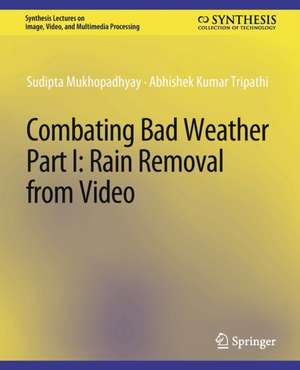Combating Bad Weather Part I: Rain Removal from Video: Synthesis Lectures on Image, Video, and Multimedia Processing
Autor Sudipta Mukhopadhyay, Abhishek Kumar Tripathien Limba Engleză Paperback – 22 dec 2014
Din seria Synthesis Lectures on Image, Video, and Multimedia Processing
-
 Preț: 428.68 lei
Preț: 428.68 lei -
 Preț: 191.30 lei
Preț: 191.30 lei -
 Preț: 206.84 lei
Preț: 206.84 lei -
 Preț: 450.88 lei
Preț: 450.88 lei -
 Preț: 234.87 lei
Preț: 234.87 lei -
 Preț: 191.30 lei
Preț: 191.30 lei -
 Preț: 264.20 lei
Preț: 264.20 lei -
 Preț: 193.01 lei
Preț: 193.01 lei -
 Preț: 260.77 lei
Preț: 260.77 lei -
 Preț: 234.87 lei
Preț: 234.87 lei -
 Preț: 234.87 lei
Preț: 234.87 lei -
 Preț: 234.87 lei
Preț: 234.87 lei -
 Preț: 234.87 lei
Preț: 234.87 lei -
 Preț: 351.41 lei
Preț: 351.41 lei -
 Preț: 234.87 lei
Preț: 234.87 lei -
 Preț: 234.87 lei
Preț: 234.87 lei -
 Preț: 262.47 lei
Preț: 262.47 lei -
 Preț: 234.87 lei
Preț: 234.87 lei -
 Preț: 206.45 lei
Preț: 206.45 lei -
 Preț: 261.53 lei
Preț: 261.53 lei
Preț: 311.69 lei
Nou
Puncte Express: 468
Preț estimativ în valută:
59.64€ • 62.44$ • 49.35£
59.64€ • 62.44$ • 49.35£
Carte tipărită la comandă
Livrare economică 05-19 aprilie
Preluare comenzi: 021 569.72.76
Specificații
ISBN-13: 9783031011238
ISBN-10: 3031011236
Ilustrații: XIII, 79 p.
Dimensiuni: 191 x 235 mm
Greutate: 0.18 kg
Editura: Springer International Publishing
Colecția Springer
Seria Synthesis Lectures on Image, Video, and Multimedia Processing
Locul publicării:Cham, Switzerland
ISBN-10: 3031011236
Ilustrații: XIII, 79 p.
Dimensiuni: 191 x 235 mm
Greutate: 0.18 kg
Editura: Springer International Publishing
Colecția Springer
Seria Synthesis Lectures on Image, Video, and Multimedia Processing
Locul publicării:Cham, Switzerland
Cuprins
Acknowledgments.- Introduction.- Analysis of Rain.- Dataset and Performance Metrics.- Important Rain Detection Algorithms.- Probabilistic Approach for Detection and Removal of Rain.- Impact of Camera Motion on Detection of Rain.- Meteorological Approach for Detection and Removal of Rain from Videos.- Conclusion and Scope of Future Work.- Bibliography.- Authors' Biographies .
Notă biografică
Sudipta Mukhopadhyay is currently Associate Professor in the Electrical and Electrical Communication Engineering, IIT Kharagpur. He received his B.E. degree from Jadavpur University, Kolkata, in 1988. He received his M.Tech. and Ph.D. degrees from IIT Kanpur in 1991 and 1996 respectively. He has served several companies including TCS, Silicon Automation Systems, GE India Technology Centre and Philips Medical Systems before joining IIT Kharagpur in 2005 as Assistant Professor of Electrical and Electrical Communication Engineering, IIT Kharagpur. In 2013 he become Associate Professor in the same department. He has authored or co-authored more than 70 publications in the field of signal and image processing. He has filed seven patents while working in industry and continued the trend after joining academia. He is a senior member of the Institute of Electrical and Electronics Engineers (IEEE), Member of SPIE and corresponding member of Radiological Society of North America (RSNA). He has done many applied projects sponsored by DIT, Intel and GE Medical Systems IT, USA. He is also founder and director of Perceptivo Imaging Technologies Private Ltd., a company under the guidance of S.T.E.P. IIT Kharagpur. The company specializes in developing innovative software for signal and image processing.Abhishek Tripathi is currently working as Senior Engineer at Uurmi Systems Pvt. Ltd., Hyderabad, India. He received his Ph.D. degree from Indian Institute of Technology Kharagpur, India, in 2012. He received the M.Tech. degree from National Institute of Technology, Kurukshetra, India, in 2008. He received the B.Tech. degree from Uttar Pradesh Technical University, Lucknow, India, in 2006. His research interests include computer vision, image-based rendering, nonlinear image processing, physics-based vision, video post processing, recognition, machine learning and medical imaging.
